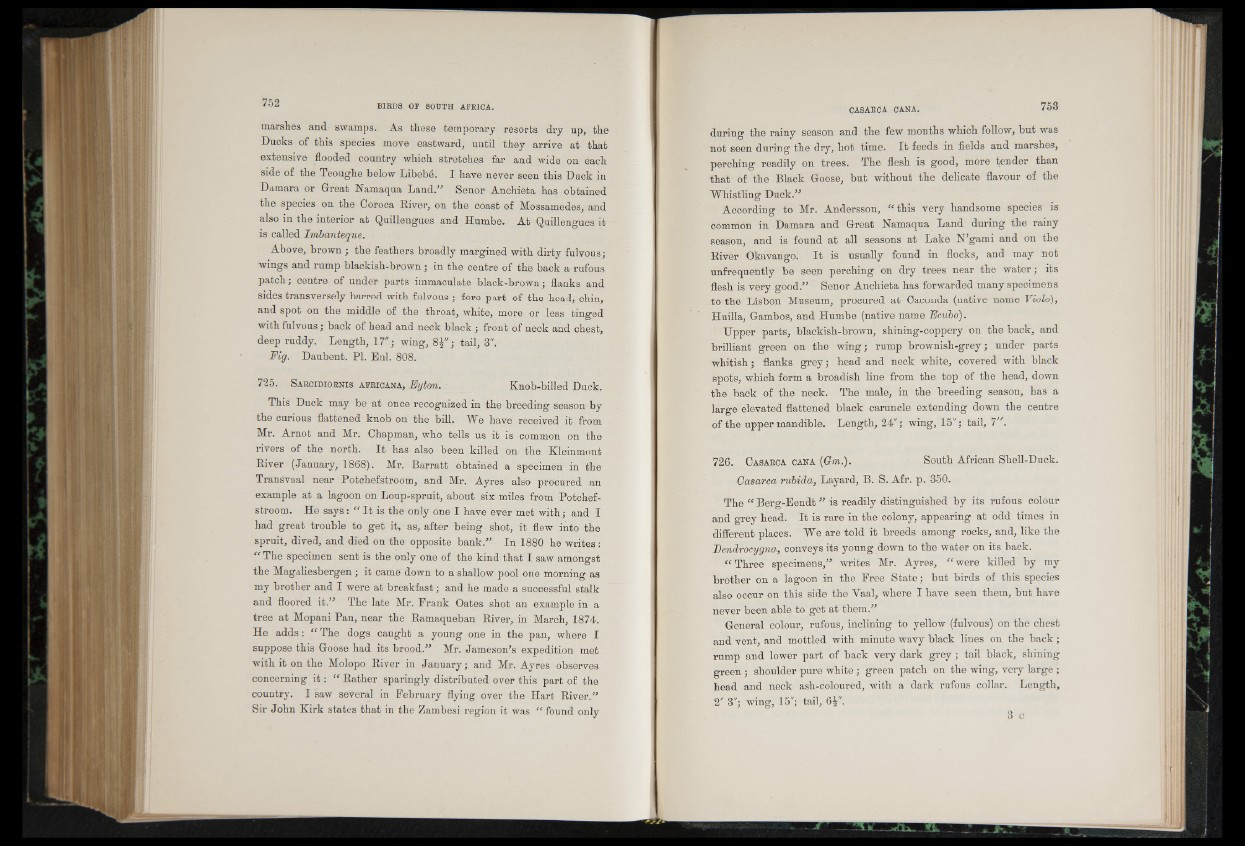
marshes and swamps. As these temporary resorts dry up, the
Ducks of this species move eastward, until they arrive at that
extensive flooded country which stretches far and wide on each
side of the Teoughe below Libebe. I have never seen this Duck in
Damara or Great Namaqua Land.” Senor Anchieta has obtained
the species on the Coroca River, on the coast of Mossamedes, and
also in the interior at Quillengues and Humbe. At Quillengues it
is called Imbanteque.
Above, brown ; the feathers broadly margined with dirty fulvous;
wings and rump blackish-brown; in the centre of the back a rufous
patch; centre of under parts immaculate black-brown; flanks and
sides transversely barred with fulvous ; fore part of the head, chin,
and spot on the middle of the throat, white, more or less tinged
with fulvous; back of head and neck black ; front of neck and chest,
deep ruddy. Length, 17"; wing, 8|"; tail, 3".
Fig. Daubent. PI. Enl. 808.
725. S a r cidio rn is africana, Eyton. Knob-billed Duck.
This Duck may be at once recognized in the breeding season by
the curious flattened knob on the bill. A\ro have received it from
Mr. Amot and Mr. Chapman, who tells us it is common on the
rivers of the north. I t has also been killed on the Kleinmont
River (January, 1868). Mr. Barratt obtained a specimen in the
Transvaal near Potchefstroom, and Mr. Ayres also procured an
example at a lagoon on Loup-spruit, about six miles from Potchefstroom.
He says: “ I t is the only one I have ever met with; and I
had great trouble to get it, • as, after being shot, it flew into the
spruit, dived, and died on the opposite bank.” In 1880 he writes:
“ The specimen sent is the only one of the kind that I saw amongst
the Magaliesbergen; it came down to a shallow pool one morning as
my brother and I were at breakfast; and he made a successful stalk
and floored it.” The late Mr. Frank Oates shot an example in a
tree at Mopani Pan, near the Ramaqueban River, in March, 1874.
He adds: “ The dogs caught a young one in the pan, where I
suppose this Goose had its brood.” Mr. Jameson’s expedition met
with it on the Molopo River in January; and Mr. Ayres observes
concerning i t : “ Rather sparingly distributed over this part of the
country. I saw several in February flying over the Hart River.”
Sir John Kirk states that in the Zambesi region it was “ found only
during the rainy season and the few months which follow, but was
not seen during the dry, hot time. It feeds in fields and marshes,
perching readily on trees. The flesh is good, more tender than
that of the Black Goose, but without the delicate flavour of the
Whistling Duck.”
According to Mr. Andersson, “ this very handsome species is
common in Damara and Great Namaqua Land during the rainy
season, and is found at all seasons at Lake N’gami and on the
River Okavango. It is usually found in flocks, and may not
unfrequently be seen perching on dry trees near the water; its
flesh is very good.” Senor Anchieta has forwarded many specimens
to the Lisbon Museum, procured at Caconda (native name Violo),
Huilla, Gambos, and Humbe (native name Er.ubo).
Upper parts, blackish-brown, shining-coppery on the back, and
brilliant green on the wing; rump brownish-grey; under parts
whitish; flanks grey; head and neck white, covered with black
spots, which form a broadish line from the top of the head, down
the back of the neck. The male, in the breeding season, has a
large elevated flattened black caruncle extending down the centre
of the upper mandible. Length, 24"; wing, 15"; tail, 7//.
726. C asarca cana (Gm.). South African Shell-Duck.
Casarca rubida, Layard, B. S. Afr. p. 350.
The “ Berg-Eendt ” is readily distinguished by its rufous colour
and grey head. It is rare in the colony, appearing at odd times in
different places. We are told it breeds among rocks, and, like the
Dendrocygna, conveys its young down to the water on its back.
“ Three specimens,” writes Mr. Ayres, “ were killed by my
brother on a lagoon in the Free State; but birds of this species
also occur on this side the Yaal, where I have seen them, but have
never been able to get at them.”
General colour, rufous, inclining to yellow (fulvous) on the chest
and vent, and mottled with minute wavy black lines on the back;
rump and lower part of back very dark grey ; tail black, shining
green ; shoulder pure white ; green patch on the wing, very large ;
head and neck ash-coloured, with a dark rufous collar. Length,
2' 3"; wing, 15"; tail, 6 |\
3 c